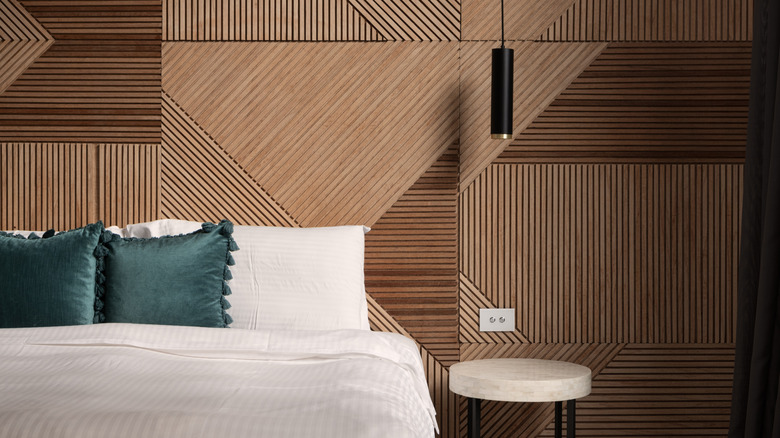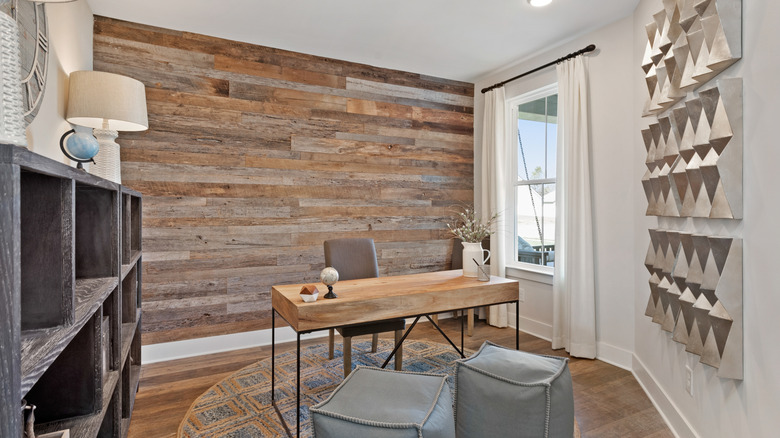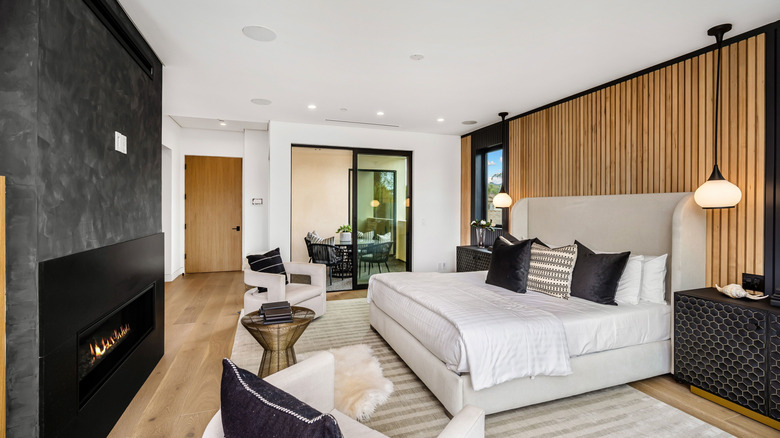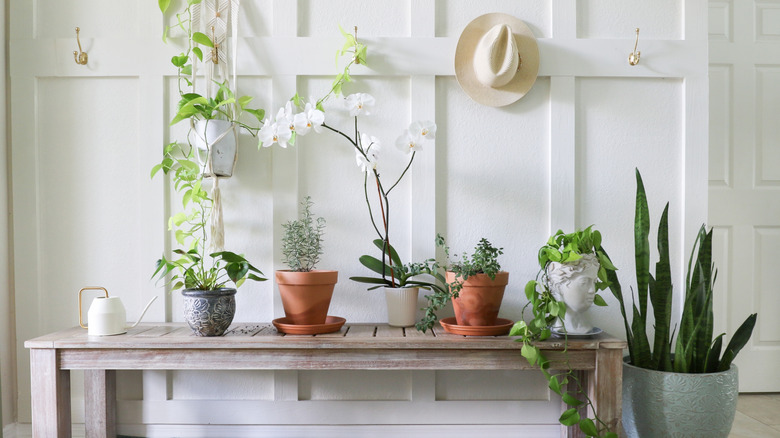Types Of Wood To Consider For Your Accent Wall
Forget the wood paneling from the 1970s that made rooms so cavern-like. A wood accent wall is like the classy cousin of this dated phenomenon: Introduce a hint of texture and warmth to your room without covering every vertical space with planks. The variety of potential looks is staggering. Do you want interesting wood grain to take the spotlight? Will the bits and pieces of wood be part of a geometric display? Or do you want boards and trim to give the look of paneling, board and batten, or shiplap? When creating wood accent walls, your desired results dictate which type of wood you should pick.
Reclaimed wood, MDF (medium density fiberboard), plywood, hardwood, or detailing made from a collection of 1-inch by 2-inch boards all leave you with drastically different results. Budget, time, degree of difficulty, and desired look come into play when you're debating which direction you want to go with your wood accent wall. Luckily, there are options that cover all of these concerns, including renter-friendly possibilities.
Where the grain is the highlight
Wood grain is beautiful in its own right, and there are so many to choose from. Whether it's reclaimed wood from a historic barn or choice pieces from free wood pallets, making the glow of natural wood the focus works for decor trends ranging from farmhouse to cabin to minimalist modern. Knotty planks that stretch the full length or width of your walls are classic and easy on the eye. An amalgam of lengths and stain colors makes a potential wooden mishmash into a clapboard-like masterpiece with the right arrangement.
Plywood has a grain that lots of us might dismiss. Boards lightly stained and mounted simply as paneling or installed on a dark wall with purposeful seams showing through takes this DIY staple way beyond utilitarian. Products like Timberchic Wooden Wall Planks adhere right to your wall and hardly require any tools or skill. They can be costly, but the reduced time and effort could make it worth the expense. The adhesive provides a permanent hold, but renters can mount it on plywood for a headboard, a miniaturized version of an accent wall that's damage-free and portable.
Pine beetle infestations are wiping out huge swaths of forest in parts of North America. The effects are devastating. Yet you can make lemonade from those lemons by using beetle kill pine as accent wood. The beetle damage streaks the wood with bluish gray, green, or even pink adding an unexpected element to a rustic wood wall. Plus, prices for beetle kill are comparable to other types of pine, which are among the cheapest types of lumber available.
Make the most of both texture and grain
Maybe you're looking toward a wood accent wall that has both a natural and dimensional aspect. Slats of 1-by-2s, stained to show off the grain and applied in close vertical rows is a very "now" take on the accent wall. Pine is an affordable option, but other woods like poplar or oak make lovely slat walls, as well. If you have a few sets of old blinds made of wood, give them a second life by using the slats as part of your accent wall. You can purchase slatted panels, also called acoustic paneling, that are much less time-consuming to hang. If your landlord doesn't mind a few screw or nail holes you'll patch before you move, acoustic panels can update the walls of your boring rental, too.
Stained wood shims mosaic-ed on a wall is an up-and-coming textural trend. Their manageable size, price, and thickness make them easy to hang, although covering an entire wall with them will be time-intensive. It may be easier to adhere shims to plywood before taking them vertical. Make the grain on shims pop with a bit of stain or just clear protectant. Place them brick-wall style, in rows of herringbone, or with purposeful imperfections for extra 3D appeal.
Painted wood hints at paneling
A painted wood-feature wall comes in many styles. Clapboard or beadboard lends a bit of cottage or farmhouse charm. Strips of painted lumber or MDF arranged as board and batten bring vintage or 21st-century vibes. These looks depend on simple arrangements, like trim attached in a boxy grid or painted vertical or horizontal boards evenly spaced or filling a wall.
MDF boards cut into strips are a great choice for these designs, since this material tends to be inexpensive, and it takes paint better than solid wood. However, opting for pieces of 1-inch-thick lumber, either 2 or 4 inches wide, can save you lots of time you'd spend cutting strips of MDF. Either of these options also work for a board and batten effect that involves affixing thin boards to painted walls. Taking the board and batten idea and giving it an angular twist has grown in recent popularity. Rather than simple vertical or horizontal placement, 1-by-2s or cuts of MDF can be the base for adventurous geometric patterns. These types of wood can be part of three-dimensional designs rife with triangles, diagonals, and perpendicular rays. Paint it to match walls' base color or to contrast with it.
Sheets of wood paneling are another possibility. Attached with a nail gun or even heavy-duty adhesive strips for a renter-friendly version, large sheets of beadboard takes less time to hang than piecing together a decorative wall from lots of individual cuts. Top it with paint, or stain it to highlight the wood's details.



